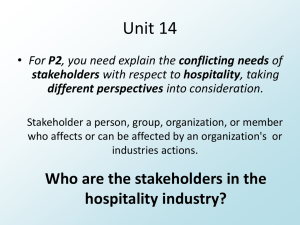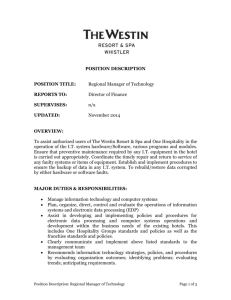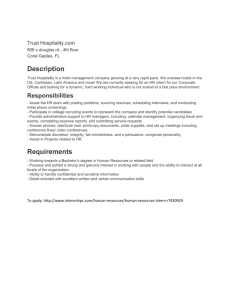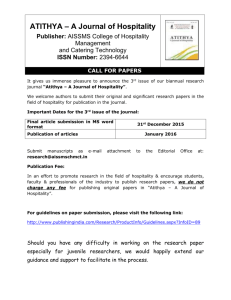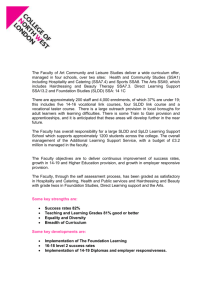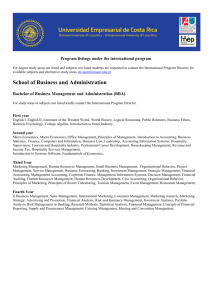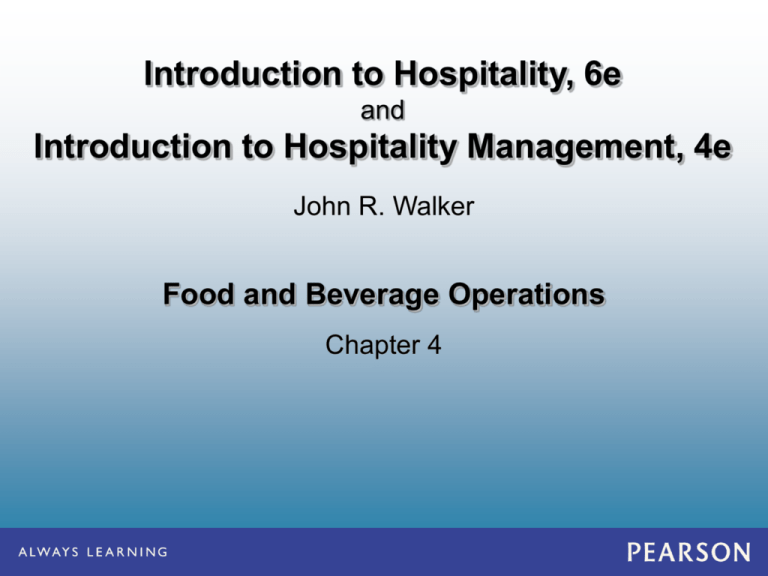
Introduction to Hospitality, 6e
and
Introduction to Hospitality Management, 4e
John R. Walker
Food and Beverage Operations
Chapter 4
Food and Beverage Management
• The director of food and beverage reports to
the general manager and is responsible for the
efficient and effective operation of the following
departments:
– Kitchen/catering/banquet
– Restaurants/room service/minibars
– Lounges/bars/stewarding
Introduction to Hospitality, 6e and Introduction to
Hospitality Management, 4e - Walker
© 2013 by Pearson Higher Education, Inc
Upper Saddle River, New Jersey 07458 • All Rights Reserved
Food and Beverage Management
• The skills needed by a food and beverage
director:
– Exceeding guests’ expectations in food and beverage
offerings and service
– Leadership
– Identifying trends
– Finding and keeping outstanding employees
– Training
– Motivation
– Budgeting
– Cost control
– Finding profit from all outlets
– Having a detailed working knowledge of the front-ofthe-house operations
Introduction to Hospitality, 6e and Introduction to
Hospitality Management, 4e - Walker
© 2013 by Pearson Higher Education, Inc
Upper Saddle River, New Jersey 07458 • All Rights Reserved
Food & Beverage Organization Chart
Figure 4.1
Introduction to Hospitality, 6e and Introduction to
Hospitality Management, 4e - Walker
© 2013 by Pearson Higher Education, Inc
Upper Saddle River, New Jersey 07458 • All Rights Reserved
Kitchen
• A hotel kitchen is under the charge of the
executive chef, or chef in smaller and mediumsized properties
• Some executive chefs are called kitchen
managers
• Controlling costs is an essential part of
operations; as labor costs represent the most
significant variable costs, staffing becomes an
important factor
• Financial results are generally expressed in
ratios, such as food cost percentage and labor
cost percentage
Introduction to Hospitality, 6e and Introduction to
Hospitality Management, 4e - Walker
© 2013 by Pearson Higher Education, Inc
Upper Saddle River, New Jersey 07458 • All Rights Reserved
Kitchen
• Labor cost benchmarks are measured by
covers-per-person-hour or how many covers
one person can produce/handle in one hour
• Food cost percentage is expressed by dividing
the food cost by food sales
• Labor cost is measured by dividing the cost of
labor by food sales.
Introduction to Hospitality, 6e and Introduction to
Hospitality Management, 4e - Walker
© 2013 by Pearson Higher Education, Inc
Upper Saddle River, New Jersey 07458 • All Rights Reserved
Food Operations
• Restaurant managers are generally
responsible for the following:
–
–
–
–
–
–
–
–
Exceeding guest service expectations
Hiring, training, and developing employees
Setting and maintaining quality standards
Marketing
Banquets
Coffee service
In-room dining, minibars, or the cocktail lounge
Presenting annual, monthly, and weekly forecasts
and budgets to the food and beverage director
Introduction to Hospitality, 6e and Introduction to
Hospitality Management, 4e - Walker
© 2013 by Pearson Higher Education, Inc
Upper Saddle River, New Jersey 07458 • All Rights Reserved
Food Operations
• The number (house count) and type of hotel
guest (e.g., the number of conference attendees
who may have separate dining arrangements)
should also be considered in estimating the
number of expected restaurant guests for any
meal.
• This figure is known as the capture rate
– When coupled with historic and banquet activity and
hotel occupancy, will be the restaurant’s basis for
forecasting the number of expected guests.
Introduction to Hospitality, 6e and Introduction to
Hospitality Management, 4e - Walker
© 2013 by Pearson Higher Education, Inc
Upper Saddle River, New Jersey 07458 • All Rights Reserved
Bars
• The profit percentage on beverages is higher
than it is on food items, making bars an
important revenue source
• The responsibilities of a bar manager include the
following:
– Supervising the ordering process and storage of
wines
– Preparing a wine list
– Overseeing the staff
– Maintaining cost control
– Assisting guests with their wine selection
– Proper service of wine
– Knowledge of beers and liquors and their service
Introduction to Hospitality, 6e and Introduction to
Hospitality Management, 4e - Walker
© 2013 by Pearson Higher Education, Inc
Upper Saddle River, New Jersey 07458 • All Rights Reserved
Bars
• Bar efficiency is measured by the pour/cost percentage
• Pour cost is obtained by dividing the cost of depleted
inventory by sales over a period of time
– Food and beverage directors expect a pour cost between 16–
24%
• Hotel bars are susceptible to the same problems as
other bars
– All beverage service staff should receive training in responsible
alcoholic beverage service
– Another risk bars encounter is pilferage
– The best way to prevent these occurrences is to have a good
control system—which should include shoppers
Introduction to Hospitality, 6e and Introduction to
Hospitality Management, 4e - Walker
© 2013 by Pearson Higher Education, Inc
Upper Saddle River, New Jersey 07458 • All Rights Reserved
Bars
• In a large hotel there are several kinds of bars:
–
–
–
–
–
–
–
–
–
Lobby bars
Restaurant bar
Service bar
Pool bars
Minibars
Night clubs
Sports bars
Casino bars
Catering and banquet bar
Introduction to Hospitality, 6e and Introduction to
Hospitality Management, 4e - Walker
© 2013 by Pearson Higher Education, Inc
Upper Saddle River, New Jersey 07458 • All Rights Reserved
Stewarding Department
• Responsibilities of Chief Steward:
– Cleanliness of back of house
– Cleanliness of glassware, china, and cutlery
– Maintaining strict inventory control and monthly
stock check
– Maintenance of dishwashing machines
– Inventory of chemical stock
– Sanitation
– Pest control
– Forecasting labor and cleaning supply needs
Introduction to Hospitality, 6e and Introduction to
Hospitality Management, 4e - Walker
© 2013 by Pearson Higher Education, Inc
Upper Saddle River, New Jersey 07458 • All Rights Reserved
Catering Department
• Catering:
– Includes a variety of occasions when people may
eat at varying times
• Banquets:
– Refers to groups of people who eat together at one
time and in one place
• Terms are used interchangeably
Introduction to Hospitality, 6e and Introduction to
Hospitality Management, 4e - Walker
© 2013 by Pearson Higher Education, Inc
Upper Saddle River, New Jersey 07458 • All Rights Reserved
Figure 4.2 Organization Chart for
the Catering Department
Introduction to Hospitality, 6e and Introduction to
Hospitality Management, 4e - Walker
© 2013 by Pearson Higher Education, Inc
Upper Saddle River, New Jersey 07458 • All Rights Reserved
Catering Department
• The director of catering (DOC) reports to the food and
beverage director, and is responsible for selling, servicing,
catering, banquets, meetings, and exhibitions
• The director of catering must be able to:
– Sell conventions, banquets, and functions.
– Lead a team of employees.
– Make up departmental goals and objectives.
– Set individual and department sales and cost budgets.
– Set service standards.
– Ensure that the catering department is properly
maintained.
– Be creative and knowledgeable about food, wine, and
service.
– Be very well versed in the likes, dislikes, and dietary
restrictions of various ethnic groups.
Introduction to Hospitality, 6e and Introduction to
Hospitality Management, 4e - Walker
© 2013 by Pearson Higher Education, Inc
Upper Saddle River, New Jersey 07458 • All Rights Reserved
Catering Department
• For meetings, a variety of room setups are
available depending on a client’s needs; the
most frequently selected meeting room setups
are:
– Theater style
– Classroom style
– Horseshoe style
Introduction to Hospitality, 6e and Introduction to
Hospitality Management, 4e - Walker
© 2013 by Pearson Higher Education, Inc
Upper Saddle River, New Jersey 07458 • All Rights Reserved
Figure 4-3, 4-4, and 4-5
Seating Styles
Introduction to Hospitality, 6e and Introduction to
Hospitality Management, 4e - Walker
© 2013 by Pearson Higher Education, Inc
Upper Saddle River, New Jersey 07458 • All Rights Reserved
Catering Event Order
• Also know as the banquet event order
– Prepared for each function to inform the client and
hotel personnel about essential information to
ensure a successful event
– Prepared based on correspondence with the client
and notes taken during the property visits
Introduction to Hospitality, 6e and Introduction to
Hospitality Management, 4e - Walker
© 2013 by Pearson Higher Education, Inc
Upper Saddle River, New Jersey 07458 • All Rights Reserved
Catering Event Order
• The Catering Event Order also mentions the
guaranteed-number policy. This is the number of
guests the hotel will prepare to serve and will
charge accordingly.
• The guaranteed number is given about seven
days prior to the event.
• The hotel will usually prepare about 3 – 5%
additional meals to cover extra attendees
Introduction to Hospitality, 6e and Introduction to
Hospitality Management, 4e - Walker
© 2013 by Pearson Higher Education, Inc
Upper Saddle River, New Jersey 07458 • All Rights Reserved
Catering Coordinator
• Manages the office and controlling the function
diary (now on the computer)
• Must see that the contracts are correctly
prepared and checks on numerous last-minute
details
• Operates web-enabled technology tools, such
as Newmarket International’s Delphi System
Introduction to Hospitality, 6e and Introduction to
Hospitality Management, 4e - Walker
© 2013 by Pearson Higher Education, Inc
Upper Saddle River, New Jersey 07458 • All Rights Reserved
Catering Services Manager (CSM)
• Duties include:
– Directing the service of all functions
– Supervising the catering house persons
– Scheduling the banquet captains and approving staffing
– Cooperating with the banquet chef to check menus and
service arrangements
– Checking that the client is satisfied
– Checking last-minute details
– Making out client bills immediately after the function
– Adhering to all hotel policies and procedures
– Calculating and distributing the gratuity and service
charges
– Coordinating the special requirements with the DOC and
catering coordinator
Introduction to Hospitality, 6e and Introduction to
Hospitality Management, 4e - Walker
© 2013 by Pearson Higher Education, Inc
Upper Saddle River, New Jersey 07458 • All Rights Reserved
Room Service/In-Room Dining
• 56% of all properties offer room service and 75% of
airport properties provide room service
• Generally, the larger the hotel and higher the room rate,
the more likely they will offer room service
• Challenges include:
–
–
–
–
Delivering orders on time—especially breakfast
Making room service profitable/forecasting demand
Avoiding complaints of excessive charges
Having well-trained and competent employees
Introduction to Hospitality, 6e and Introduction to
Hospitality Management, 4e - Walker
© 2013 by Pearson Higher Education, Inc
Upper Saddle River, New Jersey 07458 • All Rights Reserved
Sustainable Food and
Beverage Operations
• Practicing sustainable food and beverage
operations can and does lead to a better bottom
line.
• When operators save water and electricity,
recycle, and purchase local produce, they help
lessen the footprint of the operation.
• Guests are increasingly aware of the importance
of sustainable operations of a food and
Introduction to Hospitality, 6e and Introduction to
Hospitality Management, 4e - Walker
© 2013 by Pearson Higher Education, Inc
Upper Saddle River, New Jersey 07458 • All Rights Reserved
Trends
• The use of branded restaurants instead of hotels
operating their own restaurants
• Hotels opting not to offer food and beverage outlets
• Making outlets more casual
• Using themes for a restaurant
• Standardized menus
• Converting one beverage outlet into a sports-themed bar
• Technology being used to enhance guest services and
control costs
• More low-fat, low-carb menu items
Introduction to Hospitality, 6e and Introduction to
Hospitality Management, 4e - Walker
© 2013 by Pearson Higher Education, Inc
Upper Saddle River, New Jersey 07458 • All Rights Reserved
The End
Introduction to Hospitality, 6e and Introduction to
Hospitality Management, 4e - Walker
© 2013 by Pearson Higher Education, Inc
Upper Saddle River, New Jersey 07458 • All Rights Reserved

